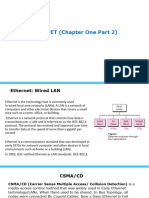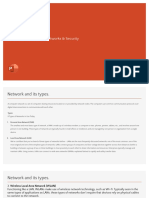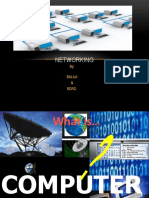0 ratings0% found this document useful (0 votes)
28 viewsNetwork Hardware
Network interface cards (NICs) connect devices to networks like the internet and have a unique MAC address. Wireless NICs (WNICs) connect via antennas instead of cables. MAC addresses identify devices and are permanent, while IP addresses can be static or dynamic depending on how they are assigned by an internet service provider. Routers allow communication between different networks by converting data between protocols.
Uploaded by
ghazanfar shahbazCopyright
© © All Rights Reserved
We take content rights seriously. If you suspect this is your content, claim it here.
Available Formats
Download as PPTX, PDF, TXT or read online on Scribd
0 ratings0% found this document useful (0 votes)
28 viewsNetwork Hardware
Network interface cards (NICs) connect devices to networks like the internet and have a unique MAC address. Wireless NICs (WNICs) connect via antennas instead of cables. MAC addresses identify devices and are permanent, while IP addresses can be static or dynamic depending on how they are assigned by an internet service provider. Routers allow communication between different networks by converting data between protocols.
Uploaded by
ghazanfar shahbazCopyright
© © All Rights Reserved
We take content rights seriously. If you suspect this is your content, claim it here.
Available Formats
Download as PPTX, PDF, TXT or read online on Scribd
You are on page 1/ 11
Network Hardware
Presented by: Mam Noor
A network interface card (NIC) is needed to allow a device to
connect to a network (such as the internet).
It is usually part of the device hardware and contains the Media
Access Control (MAC) address generated at the manufacturing
Network stage.
Wireless network interface cards/controllers (WNICs) are the same
interface card as NICs in that they are used to connect devices to the internet or
(NIC) other networks.
However, they use wireless connectivity utilising an antenna to
communicate with networks via microwaves.
They would normally plug into the USB port or be part of an
internal integrated circuit.
A MAC address is made up of 48 bits which are shown as six
groups of hexadecimal digits with the general format:
Media Access
Control (MAC) For example, 00 – 1C – B3 – 4F – 25 – FF where the first six hex digits
identify the device as made by, for example, Apple and the second
set of six hex digits are the serial number of the device itself (this is
unique). If the NIC card is replaced, the MAC address will also
change
There are two types of MAC address:
the Universally Administered MAC Address (UAA)
Types of MAC the Locally Administered MAC Address (LAA)
address However, there are some occasions when a user or organisation
wishes to change their MAC address. This is a relatively easy task
to carry out, but it will cause big problems if the changed address
isn’t unique.
There are a few reasons why the MAC address needs to be
changed using LAA:
» certain software used on mainframe systems need all the MAC
addresses of devices to fall into a strict format; because of this, it
may be necessary to change the MAC address of some devices to
ensure they follow the correct format
Types of MAC » it may be necessary to bypass a MAC address filter on a router or
address a firewall; only MAC addresses with a certain format are allowed
through, otherwise the devices will be blocked if their MAC
address doesn’t adhere to the correct format
» to get past certain types of network restrictions it may be
necessary to emulate unrestricted MAC addresses; hence it may
require the MAC address to be changed on certain devices
connected to the network
When a device connects to a private network, a router assigns a
private IP address to it.
That IP address is unique on that network, but might be the same as
an IP address on a separate network.
However, when a router connects to the internet it is given a unique
public IP address.
Internet . All the devices connected to that router have the same public IP
protocol (IP) address as the router but each have their own different private IP
addresses on that network.
address Because the operation of the internet is based on a set of protocols
(rules), it is necessary to supply an IP address.
Protocols define the rules that must be agreed by senders and
receivers of data communicating through the internet.
There are two versions of IP: IPv4 and IPv6. IPv4 is based on 32 bits
and the address is written as four groups of eight bits (shown in
denary format);
. The main advantages of IPv6 compared to IPv4 are:
» removes the risk of IP address collisions
» has built-in authentication checks
» allows for more efficient packet routes.
Table 3.13 compares the features of MAC addresses and IP
addresses
Advantages of
IPV
Dynamic and
static IP
address
Static and dynamic IP addresses IP addresses can be either static
(don’t change) or dynamic (change every time a device connects
to the internet).
Static Static
IP addresses are permanently assigned to a device by the internet
Static and service provider (ISP); they don’t change each time a device logs
onto the internet.
dynamic IP Static IP addresses are usually assigned to:
addresses » remote servers which are hosting a website
» an online database
» a File Transfer Protocol (FTP) server. FTP servers are used when
files need to be transferred to various computers throughout the
network
Dynamic Dynamic IP addresses are assigned by the ISP each time
a device logs onto the internet.
This is done using Dynamic Host Configuration Protocol (DHCP).
A computer on the internet, configured as a DHCP server, is used
by the ISP to automatically assign an IP address to a device.
Static and As the name suggests, a dynamic IP address could be different
every time a device connects to the internet.
dynamic IP Table 3.14 compares static and dynamic IP addresses:
addresses
Routers enable data packets to be routed between different
networks, for example, to join a LAN to a WAN.
The router takes data transmitted in one format from a network
(which is using a particular protocol) and converts the data to a
protocol and format understood by another network, thereby
allowing them to communicate.
A router would typically have an internet cable plugged into it and
Routers several cables connecting to computers and other devices on the
LAN.
You might also like
- LPI - Selftesttraining.202 450.v2019!02!20.by - Mark.65qNo ratings yetLPI - Selftesttraining.202 450.v2019!02!20.by - Mark.65q38 pages
- Network Hardware - IP Address and Its Types and MAC AddressNo ratings yetNetwork Hardware - IP Address and Its Types and MAC Address25 pages
- 14 Communication and Internet TechnologiesNo ratings yet14 Communication and Internet Technologies26 pages
- IP Address and MAC Address: Prepared By: Supervised byNo ratings yetIP Address and MAC Address: Prepared By: Supervised by10 pages
- Unit 1: Advanced Computer Networks & SecurityNo ratings yetUnit 1: Advanced Computer Networks & Security64 pages
- Networking-Interview-Questions-With-Answers-PDF (1)No ratings yetNetworking-Interview-Questions-With-Answers-PDF (1)8 pages
- Computer Networking: An introductory guide for complete beginners: Computer Networking, #1From EverandComputer Networking: An introductory guide for complete beginners: Computer Networking, #14.5/5 (2)
- Cisco Network Administration Interview Questions: CISCO CCNA Certification ReviewFrom EverandCisco Network Administration Interview Questions: CISCO CCNA Certification Review4.5/5 (6)
- Static Routing Introduction To Dynamic Routing Protocols RIP v1 and RIP v2, OSPF Eigrp BGPNo ratings yetStatic Routing Introduction To Dynamic Routing Protocols RIP v1 and RIP v2, OSPF Eigrp BGP12 pages
- Hybrid Cloud Observability - Network Monitoring Participant's GuideNo ratings yetHybrid Cloud Observability - Network Monitoring Participant's Guide35 pages
- By Palo Alto Networks - PA-3200 Series - DatasheetNo ratings yetBy Palo Alto Networks - PA-3200 Series - Datasheet3 pages
- Festo - CPX Terminal - FB36.PSI - US PDFNo ratings yetFesto - CPX Terminal - FB36.PSI - US PDF2 pages
- CS-2500 ASTM Host Interface Specifications for US Revision 2.04 DXDCM 0900ac6d80e03f8f-1560789024432No ratings yetCS-2500 ASTM Host Interface Specifications for US Revision 2.04 DXDCM 0900ac6d80e03f8f-156078902443257 pages
- Routing Authentication and Passive InterfacesNo ratings yetRouting Authentication and Passive Interfaces3 pages
- SIM7020 Series - TLS - Application Note - V1.03No ratings yetSIM7020 Series - TLS - Application Note - V1.0310 pages
- NetFlow_IPFIX Exporting with pmacct – Bits 'n BytesNo ratings yetNetFlow_IPFIX Exporting with pmacct – Bits 'n Bytes6 pages
- Chapter 2: Wireless IP Network Architectures: Jyh-Cheng Chen and Tao ZhangNo ratings yetChapter 2: Wireless IP Network Architectures: Jyh-Cheng Chen and Tao Zhang148 pages
- Traffic Policing: Finding Feature InformationNo ratings yetTraffic Policing: Finding Feature Information6 pages
- Cisco 2960 Switch Configuration Commands Step by Step - Configuring CiscoNo ratings yetCisco 2960 Switch Configuration Commands Step by Step - Configuring Cisco8 pages
- CP-TNW-HP24G2F1-30 Manual - 13.238.101.1480No ratings yetCP-TNW-HP24G2F1-30 Manual - 13.238.101.14802 pages
- 1 28701 FGC 101 3441 Router 6471 Datasheet Rev G PDFNo ratings yet1 28701 FGC 101 3441 Router 6471 Datasheet Rev G PDF2 pages
























































































